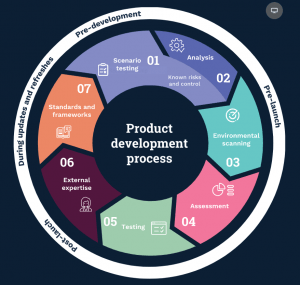Best-selling Author Mark Manson: “Technology has solved old economic problems by giving us new psychological problems. The Internet has not just open-sourced information, it has also open-sourced insecurity, self-doubt, and shame.” I am not amplifying the ills of digital but I thought it’s important we put the discussion in perspective and by that I am for children.
” Pathways: How digital design puts children at risk “is a recent study by the 5Rigths Foundation UK which highlights the profound carelessness and disregard for children embedded in the features, products, and services of children which is becoming the norm of the digital world. The report goes on to suggest that any product which puts children at risk per its architecture and not by accident falls within the 5Rights Foundation’s Risky by Design initiative definition. The hard truth is no connected child is exempt from the demands of the digital world and no child can be supervised 24/7 which is why responsibility for child safety should be co-owned.
No wonder Mark Manson in his book described the internet as being an open-sourced of everything. The Digital Pathways report brought to light the commercial objectives employed by design professionals and innovators to build features compelling children to spend a lot of time on the platforms. It sometimes makes it very confusing for to accept themselves as who they really are because they are shown filters refined images for which they aspire to be. It is obvious the companies make money from the attention of children and without the attention-grabbing features it will be difficult for them to make their profit.
An ideal digital design with children’s needs in mind ought to consider the age of children, their cognitive ability, their digital literacy level and finally children’s maturation. This level cannot be attained by assumptions but must be based on empirical evidence from research before, during and after the product is designed which is to say safety standards should be activated within the design frame per the desired goal of the product and the Best interest of children.
Unfortunately, the digital which is often privately owned seems to unleash man and woman-made risks onto children by collecting data or monitoring or even exposed children to contents they have no control over. So, the digital environment for which children have rights to has become an open-source of graphic images of self-harm, extreme diets, pornography, extremist content and introductions to adult strangers, all ubiquitous in many places and spaces that children inhabit – ranked, recommended and promoted to them at industrial scale.
Last year during the lockdown news broke out about the South African parliamentary session zoom-bombing among other incidences in so many spaces including children’s classrooms.

About 3 years ago and from experience the eSafety Commission of Australia introduced the Safety By Design Initiative. Safety by Design puts user safety and rights at the center of the design and development of online products and services. Rather than retrofitting safeguards after an issue has occurred, Safety by Design focuses on the ways technology companies can minimize online threats by anticipating, detecting and eliminating online harms before they occur. This also require designs that will make it difficult for the Child to enter into the extreme zone, where they get further exposed to predators and get access to extreme or harmful contents.
This proactive and preventative approach focuses on embedding safety into the culture and leadership of an organization. It emphasizes accountability and aims to foster more positive, civil and rewarding online experiences for everyone. This brings into play the Child’s digital citizenship skills, the child as a conscious citizen online knowing the ills and good related to technology Which only comes from building the Child’s capacity.
The assessment tool built on Safety by Design assessment tools and resources for start-up, mid-tier and enterprise companies is aimed at supporting small and large companies globally to put safety and ethical consideration at the heart of business and to steer clear from regulatory, reputational and revenue risks. I call on you to subject your product to the Safety By Design assessment at https://sbd.esafety.gov.au/ It is an easy call to regulate and counter harmful content and design features which might result in a particular product to prioritize safety over profit.
Addressing Child Online Protection concerns in Africa hinges on five strategic pillars and until all those pillars speak to each other it could be difficult to achieve the desired goal of self-regulation /co-regulation in the interest of the African child.
The Safety By Design initiative is one of the Best Practices for industry mentioned in the International Telecommunications Union (ITU) guidelines for industry www.itu.int/COP Any company that imbibes the Safety By Design frames is able to integrate formal safety consideration reviews: – including consultation and testing -into the safety by design process from start to finish.
This is not to say that with this done children are protected automatically however it means a giant leap made and this in addition to digital literacy promoted within the classroom can go a long way to safeguarding the best interest of children.
Every aspects of the ecosystem needs Safety By Design in order to create the kind of world in which everyone is safe.
The Author is the Executive Director at Child Online Africa










